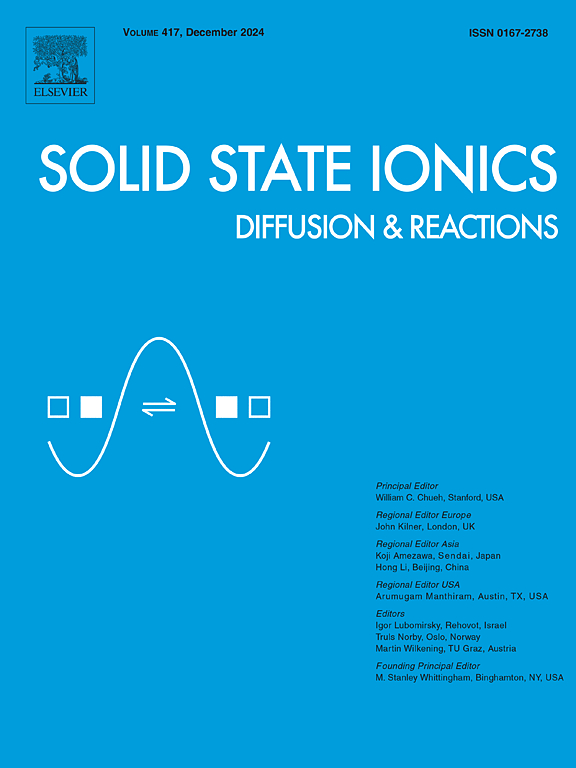增强 LiSiPON 薄膜电解质的离子导电性:克服与前驱体目标中锂离子迁移有关的合成难题
IF 3
4区 材料科学
Q3 CHEMISTRY, PHYSICAL
引用次数: 0
摘要
目前,通过磁控溅射法制备的非晶锂离子电池是最常用的薄膜电解质,因为它具有离子导电性(∼10-6 S.cm-1)、可忽略不计的电子导电性、无晶界和钝化锂金属的能力。尽管这种特性组合具有出色的循环性能,但由于在通信阶段需要短而大的电流脉冲,其适中的导电性阻碍了微型电池在物联网应用中的使用。为了更好地满足这一要求,人们合成了离子电导率比 LiPON 高十倍以上的 LiSiPON 薄膜,但在合成的成分控制和可重复性方面遇到了一些挑战。在这里,我们用一组具有不同锂浓度的前驱体靶合成了 LiSiPON 薄膜。主要结果表明,靶材料中锂含量的增加会显著提高其离子导电性。奇怪的是,导电性最强的靶材产生的薄膜缺锂且导电性差,在成分和电气性能方面的可重复性也不高。我们的研究结果表明,锂从溅射区域(或赛道)向外迁移,而靶材的高离子导电性有利于锂的迁移,这就是产生缺锂薄膜的原因。最后,我们成功制备出了具有足够低锂离子电导率的 LiSiPO 靶材,从而实现了高导电性 LiSiPON 固体电解质的可重复沉积。本文章由计算机程序翻译,如有差异,请以英文原文为准。
Enhancing ionic conductivity of LiSiPON thin films electrolytes: Overcoming synthesis challenges related to Li-migration in the precursor target
Currently, amorphous LiPON prepared by magnetron sputtering is the most employed thin film electrolyte due to its ionic conductivity (∼10−6 S.cm−1), negligible electronic conductivity, absence of grain boundaries and ability to passivate Li metal. Despite the outstanding cycling performance that this combination of properties enables, its moderate conductivity hinders the use microbatteries in Internet of Things applications due to the need for short but high current pulses during communication phases. To better meet this requirement, LiSiPON thin films with ionic conductivities more than ten times greater than that of LiPON have been synthesized, while encountering some challenges in controlling the composition and the reproducibility of the synthesis. Herein, we have synthesized LiSiPON thin films from a set of precursor targets having distinct lithium concentrations. The main results indicate that an increase in the lithium content in the target material significantly enhances its ionic conductivity. Curiously, the most conductive target results in lithium-deficient and poorly conductive thin films that are not particularly reproducible in terms of composition and electrical properties. Our results suggest that lithium migration away from the sputtered area (or racetrack), favored by the high ionic conductivity of the target, is the origin of the resulting Li-deficient films. Finally, we have succeeded in preparing LiSiPO targets with sufficiently low Li-ion conductivity that enable the reproducible deposition of highly conductive LiSiPON solid electrolytes.
求助全文
通过发布文献求助,成功后即可免费获取论文全文。
去求助
来源期刊

Solid State Ionics
物理-物理:凝聚态物理
CiteScore
6.10
自引率
3.10%
发文量
152
审稿时长
58 days
期刊介绍:
This interdisciplinary journal is devoted to the physics, chemistry and materials science of diffusion, mass transport, and reactivity of solids. The major part of each issue is devoted to articles on:
(i) physics and chemistry of defects in solids;
(ii) reactions in and on solids, e.g. intercalation, corrosion, oxidation, sintering;
(iii) ion transport measurements, mechanisms and theory;
(iv) solid state electrochemistry;
(v) ionically-electronically mixed conducting solids.
Related technological applications are also included, provided their characteristics are interpreted in terms of the basic solid state properties.
Review papers and relevant symposium proceedings are welcome.
 求助内容:
求助内容: 应助结果提醒方式:
应助结果提醒方式:


